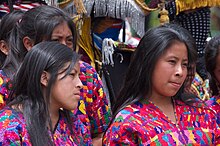Maya Ethnic Group and Population
- Maya are an ethnolinguistic group of indigenous peoples of Mesoamerica
- The ancient Maya civilization was formed by members of this group
- Today, Maya inhabit southern Mexico, Guatemala, Belize, El Salvador, Nicaragua, and Honduras
- The term 'Maya' is a modern collective term for the peoples of the region
- There was no common sense of identity or political unity among the distinct populations, societies, and ethnic groups
- It is estimated that seven million Maya were living in the area at the start of the 21st century
- Guatemala, southern Mexico, Belize, El Salvador, and western Honduras have maintained remnants of their ancient cultural heritage
- Some Maya are integrated into majority Hispanic cultures, while others maintain a traditional, culturally distinct life
- The largest populations of contemporary Maya inhabit Guatemala, Belize, western Honduras, El Salvador, and northern Nicaragua
- The Yucatan Peninsula has a large population of Maya who identify themselves simply as Maya without further ethnic subdivision
Language and Identity
- The Maya language is referred to as Yucatec or Yucatec Maya
- The correct name for the people is simply Maya, not Mayans
- Maya women who use traditional dress identify as mestiza, not Maya
- Ethnic self-identification as Maya is variable and situational
- Some Maya people identify as Christians rather than Maya
Historical Interactions with Europeans
- The Yucatan Peninsula's indigenous population was first exposed to Europeans in 1511
- Spanish expeditions led by Córdoba, Grijalva, and Cortés explored the region
- Francisco Montejo's attempts to conquer the Yucatan failed initially
- European diseases, native recruitment, and internal conflicts eventually led to the conquest of Chichen Itza
- The western Yucatan Peninsula surrendered to the Spanish in 1542
Maya Identity in Modern Times
- Between 750,000 and 1,200,000 people in the Yucatan Peninsula speak Mayan
- Many people of Maya origins hold ancient Maya surnames and do not speak Mayan as their first language
- The Caste War of Yucatan was a successful revolt by the native Maya people
- The Maya state of Chan Santa Cruz was recognised as an independent nation by the British Empire
- Politicians of Maya heritage have held various offices in the Yucatan Peninsula, including governor
Maya Cultural Heritage and Tourism
- Maya people are known for their brightly colored textiles, such as capes, shirts, blouses, huipiles, and dresses.
- Each village has its own distinctive pattern, allowing people to identify someone's hometown.
- Maya religion is a combination of Roman Catholicism and indigenous Maya beliefs.
- The syncretic religion prevailed throughout the country, especially in rural regions.
- Protestant Pentecostalism has become the predominant religion in urban centers and some rural areas.
- Cultural tourism plays a significant role in constructing national identities for the Maya.
- Cultural tourism focuses on lifeways, such as costumes, rituals, diet, handicrafts, language, and housing.
- Cultural tourism represents a large portion of global tourism, estimated to be around 35-40%.
- Historic symbols and topics in tourism contribute to nation-building.
- Ethno-commerce in tourism can create value but may also lead to the invention of artificial attractions.
The Maya (/ˈmaɪə/) are an ethnolinguistic group of indigenous peoples of Mesoamerica. The ancient Maya civilization was formed by members of this group, and today's Maya are generally descended from people who lived within that historical region. Today they inhabit southern Mexico, Guatemala, Belize, El Salvador, Nicaragua, and Honduras. "Maya" is a modern collective term for the peoples of the region; however, the term was not historically used by the indigenous populations themselves. There was no common sense of identity or political unity among the distinct populations, societies and ethnic groups because they each had their own particular traditions, cultures and historical identity.
 Flag of the Mayan people | |
 | |
| Total population | |
|---|---|
| c. 8 million+ (2018) Pre-Columbian: 5–10 million | |
| Regions with significant populations | |
| Parts of modern-day countries of Guatemala, Mexico, United States, Belize, Honduras, Nicaragua, and El Salvador | |
| 7,140,503 (2018) | |
| 1,475,575 (2000) | |
| 500,000 (2011) | |
| 30,107 (2010) | |
| 1,333,256 (2013) | |
| 1,130,876 (2010) | |
| Languages | |
| Mayan languages, English, Spanish, and Kriol | |
| Religion | |
| Christianity and Maya religion | |

It is estimated that seven million Maya were living in this area at the start of the 21st century. Guatemala, southern Mexico and the Yucatán Peninsula, Belize, El Salvador, and western Honduras have managed to maintain numerous remnants of their ancient cultural heritage. Some are quite integrated into the majority hispanicised mestizo cultures of the nations in which they reside, while others continue a more traditional, culturally distinct life, often speaking one of the Mayan languages as a primary language.
The largest populations of contemporary Maya inhabit Guatemala, Belize, the western portions of Honduras and El Salvador, and the northern portion of Nicaragua as well as large segments of population within the Mexican states of Yucatán, Campeche, Quintana Roo, Tabasco, and Chiapas.